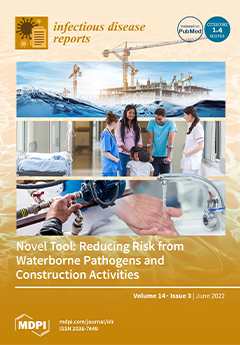Background: One of the main challenges in the management of COVID-19 patients is to early assess and stratify them according to their risk of developing severe pneumonia. The alveolar–arterial oxygen gradient (D(A-a)O
2) is defined as the difference between the alveolar and
[...] Read more.
Background: One of the main challenges in the management of COVID-19 patients is to early assess and stratify them according to their risk of developing severe pneumonia. The alveolar–arterial oxygen gradient (D(A-a)O
2) is defined as the difference between the alveolar and arteriolar concentration of oxygen, an accurate index of the ventilatory function. The aim of this study is to evaluate D(A-a)O
2 as a marker for predicting severe pneumonia in COVID-19 patients, in comparison to the PaO
2/FiO
2. Methods: This retrospective, multicentric cohort study included COVID-19 patients admitted to two Italian hospitals between April and July 2020. Clinical and laboratory data were retrospectively collected at the time of hospital admission and during hospitalization. The presence of severe COVID-19 pneumonia was evaluated, as defined by the Infectious Diseases Society of America (IDSA) criteria for community-acquired pneumonia (CAP). Patients were divided in severe and non-severe groups. Results: Overall, 53 COVID-19 patients were included in the study: male were 30/53 (57%), and 10/53 (19%) had severe pneumonia. Patients with severe pneumonia reported dyspnea more often than non-severe patients (90% vs. 39.5%;
p = 0.031). A history of chronic obstructive pulmonary disease (COPD) was recalled by 5/10 (50%) patients with severe pneumonia, and only in 6/43 (1.4%) of non-severe cases (
p = 0.023). A ROC curve, for D(A-a)O
2 >60 mmHg in detecting severe pneumonia, showed an area under the curve (AUC) of 0.877 (95% CI: 0.675–1), while the AUC of PaO
2/FiO
2 < 263 mmHg resulted 0.802 (95% CI: 0.544–1). D(A-a)O
2 in comparison to PaO
2/FiO
2 had a higher sensibility (77.8% vs. 66.7%), positive predictive value (75% vs. 71.4%), negative predictive value (94% vs. 91%), and similar specificity (94.4% vs. 95.5%). Conclusions: Our study suggests that the D(A-a)O
2 is more appropriate than PaO
2/FiO
2 to identify COVID-19 patients at risk of developing severe pneumonia early.
Full article






